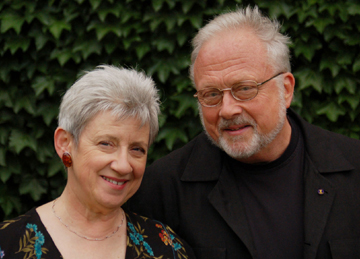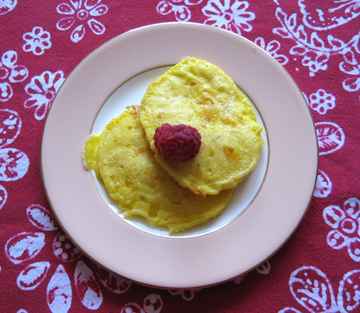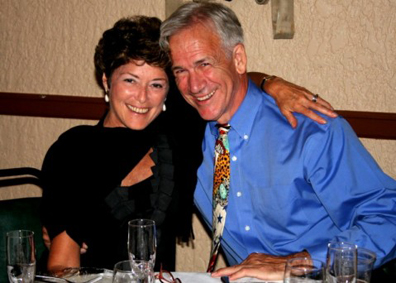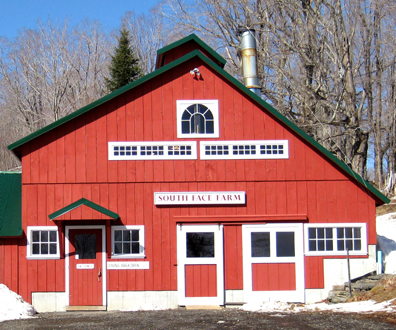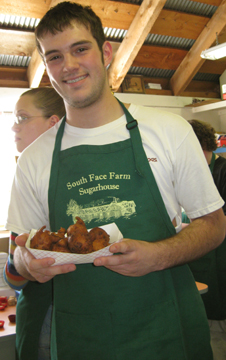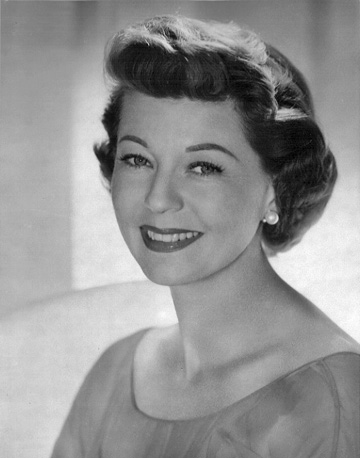
Harriet Hilliard Nelson (Courtesy of MortysTV.com)
Tomorrow the matriarch of “America’s favorite family” would have turned 100.
Born Peggy Lou Snyder on July 18, 1909, Harriet Hilliard Nelson grew up in a theatrical family that used the name Hilliard (definitely classier than Snyder!). She worked as a chorus dancer and an actress before trying her hand as a singer and nightclub mistress of ceremonies. In 1932 she started singing with bandleader Ozzie Nelson’s orchestra, beginning a professional and personal partnership that would last until Ozzie’s death in 1975. (Harriet herself died in 1994.)
In the 1930s Harriet still worked solo from time to time. Her biggest role came in the 1936 Astaire-Rogers film Follow the Fleet, playing the romantic second lead opposite Randolph Scott. One can glimpse the singer she was—and the actress she might have become—in that film, where she is attractive and has a sultry if smallish voice.
Increasingly, however, she worked only with Ozzie. After the birth of their two children, David (in 1936) and Eric (known as Ricky and later Rick, in 1940), the couple began performing on the radio. This medium enabled Ozzie and Harriet to maintain a more stable home life than nightclub work could offer.
They launched their signature radio program, The Adventures of Ozzie and Harriet, in 1944. The program allegedly followed the real-life story of the couple and their sons. The latter were played on the radio by actors. When the Adventures expanded to television in 1952, David and Ricky were brought in to portray themselves.
The televised Adventures of Ozzie and Harriet became one of the best known American situation comedies of the 1950s and 1960s. The program is sometimes irritating to view today. (I had to watch A LOT of episodes while doing research for my dissertation so I should know!) Like Ozzie’s rather bland orchestra, it tended, in the words of one critic, to “[border] very much on the Babbitt.”
By the time they hit television Ozzie and Harriet were primarily actors rather than musicians, although they sang in a few episodes. Young Rick sang increasingly beginning in 1959, when under his father’s watchful eye he became a recording star.
Even after Rick emerged as a singing sensation the major emphasis of the television program was on family life—specifically on the dilemmas of males, both grown up (Ozzie) and growing up (David and Ricky). Ozzie’s character was awash with insecurity. He was never sure he was brave enough, strong enough, or rugged enough— in short, masculine enough. In the final analysis, then, the only character in the program who seemed like a true grown up was Harriet.
Although her character was allowed occasional wisecracks, she generally represented reason and stability. Harriet Nelson played this character with grace and a certain amount of charm, but I frequently find myself wondering what the televised Harriet might have been like freed of Ozzie and the boys.
The same question comes to mind about the offscreen Harriet Nelson. She was portrayed in magazines and newspapers of the 1950s as a quiet homemaker who viewed her work on the family’s show as an old-fashioned pre-industrial cottage industry, a suitable accompaniment to her collection of early-American antiques. Nevertheless, no true personality peeks out of those pages.
Ozzie was described in the press as an efficient producer and director of the show; one can sense the iron hand with which he ruled the family as well as the program. The younger Nelsons were described as fairly normal boys who just happened to be the stars of a television show. While this was undoubtedly an exaggeration, they had definite personalities. The “real” Harriet disappeared from press coverage, however, just as her earlier vivacity disappeared from the television program. Behind the pretty smile and the smooth, tailored dresses lurked an enigma.
I hope the Harriet we never really knew managed to enjoy herself. I like to think that her on- and offscreen rationality and blandness camouflaged a busy, happy existence.
In any case, I use the recipe below to salute her competence as an actress and her status as one of America’s best known television personalities. (A 1965 New Yorker cartoon celebrated the Nelsons’ iconic status; in it a TV-watching wife tells her husband, “I’ll make a deal with you. I’ll try to be more like Harriet if you’ll try to be more like Ozzie.”)
The recipe was inspired by the episode “Pancake Mix” in the televised Adventures’ first season. In this half hour Harriet tries a new product, Hasty Tasty Pancake Mix. The Irrepressible Ricky (as he was often called by the program’s announcer) tries to get rich by exploiting the promise of the Hasty Tasty company to refund twice the purchase price of its product if the mix doesn’t make the finest pancakes the eater has ever tasted.
Ricky learns his lesson (sort of) when the pancake-mix president shows up at the Nelson home with a retinue and prepares a batch of pancakes on the spot—adorned with chocolate ice cream, strawberry jam, whipped cream, and a cherry.
Naturally, Ricky declares that these are ABSOLUTELY the finest pancakes he has ever tasted. Mine weren’t bad, either—or so my nephew Michael told me. He ate them with maple syrup. I was careful not to mention the trimmings Ricky enjoyed until after we had finished eating!
Enjoy them—and think of Harriet in her perfectly pressed apron, competently flipping them on her Hotpoint kitchen range….
Hasty Tasty Pancake Mix
You may double this recipe easily. In fact, you may make up to EIGHT TIMES as much mix as the recipe suggests; just make sure that it is well mixed together.
Ingredients:
1 cup flour
1/4 cup buttermilk powder (in larger grocery stores under “baking needs”)
1/4 teaspoon salt
1/2 teaspoon baking soda
1 tablespoon sugar
1 teaspoon baking powder
Instructions:
Sift together these ingredients, and whisk them as well to make sure that they are thoroughly combined. Store the mix in an airtight container until it is needed (but not for more than 3 months!).
To make a batch of pancakes: In a bowl whisk together 1 cup water, 1 egg, and 2 tablespoons melted butter. Gently stir in the pancake mix. Do not overmix the batter.
Heat a frying pan or skillet to medium heat (about 375 degrees), and melt a small amount of butter into it. Dollop just under 1/4 cup batter onto the pan for each pancake.
Turn the pancakes after a minute or two, when they are nice and bubbly on the surface and easy to lift; then cook them on the other side. Add a bit more butter as needed to prevent sticking. Remove and serve with butter and warm maple syrup—or ice cream, jam, whipped cream, and a cherry. Each recipe makes about 10 pancakes.
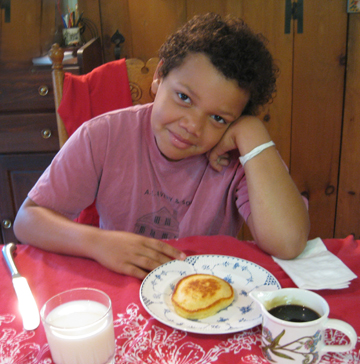
The Irrepressible Michael contemplates a Hasty Tasty Pancake. (I think he's ready to utter Ricky's favorite line, "I don't mess around, boy!")
If you enjoyed this post, please consider taking out an email subscription to my blog. It features easy but tasty country recipes with occasional musings on history, popular culture, and family life. Just click on the link below!

